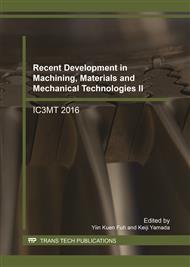p.141
p.148
p.154
p.161
p.171
p.178
p.185
p.191
p.199
The Effect of Heating to the Formability of Titanium Sheet by SPIF Technology
Abstract:
In several last decades, Single Point Incremental Forming named as SPIF, a branch of Incremental Sheet Forming (ISF), is an advanced flexible manufacturing process to produce complex 3D sheet products especially for unique models such as personal cranium, cheek-bone,…applied in surgery. Presently, the SPIF technology has been continuously studied, applied and perfected for metal sheet manufacturing, especially Titanium and its alloys in some industrial sectors like aerospace, chemical engineering, and medical surgery. However, the formability of Titanium alloys is limited at room temperature that causes so many failures and tears of sheet workpiece when forming. This paper recommends a measure of increasing the plasticity of the formed metal sheet by heating. This paper studies on the effect of the control of temperature to increase the plasticity of the sheet workpiece. The accuracy of dimensions of the products under the effect of springback phenomenon in forming process at normal and high temperature of workpiece is also studied to show the effect of hot SPIF. The design of experiment (DOE) is also mentioned in this paper to select a set of suitable input parameters for the empirical process.
Info:
Periodical:
Pages:
171-177
Citation:
Online since:
August 2017
Keywords:
Price:
Сopyright:
© 2017 Trans Tech Publications Ltd. All Rights Reserved
Share:
Citation:


